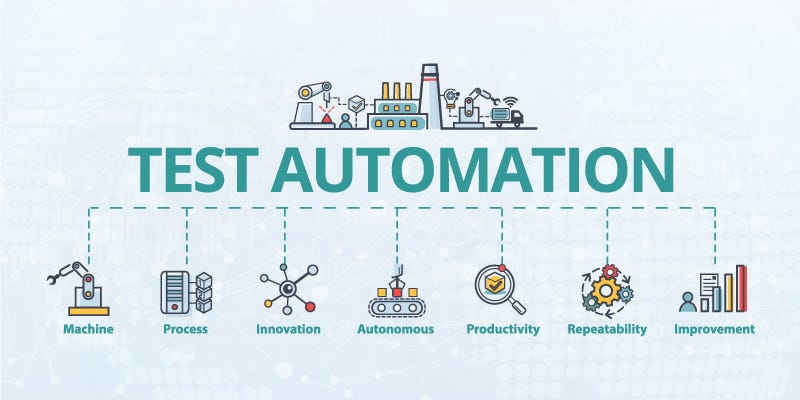Automation Testing Approaches: Best Practices for Seamless Integration
Automation Testing Approaches: Best Practices for Seamless Integration
Blog Article
From Manual to Automated Testing: A Comprehensive Guide to Transitioning Efficiently and Successfully
In the realm of software screening, the change from manual to automated procedures has come to be an increasingly vital shift for companies seeking to improve performance and accuracy in their testing methods. As innovation proceeds to advance, the demand for reliable and seamless automated testing techniques has actually never been a lot more important. The journey from guidebook to automated screening is not without its challenges, but when approached strategically and with a clear strategy in mind, the advantages can be substantial - automation testing. In this extensive guide, we will explore key actions and considerations crucial for a successful change, from the preliminary choice of tools to the combination of automation right into existing operations. Remain tuned to discover the insights that will certainly assist lead the means for a smoother and more reliable testing procedure.
Benefits of Automated Evaluating
Automated testing offers various advantages, boosting performance and accuracy in software program growth procedures. One primary benefit is the substantial reduction in screening time. Automated examinations can be run all at once on numerous gadgets and operating systems, drastically speeding up the testing stage compared to hand-operated testing. This increased efficiency enables for faster feedback on the high quality of the software, making it possible for designers to identify and attend to issues without delay.
Furthermore, automated screening makes certain a higher level of accuracy in finding problems. Considering that automated tests adhere to predefined scripts, human mistake is lessened, resulting in more reputable examination outcomes. Consistency in testing is likewise improved, as automated examinations perform the same steps precisely each time they are run. This consistency is important in making sure that all performances of the software application are thoroughly evaluated, reducing the probability of unnoticed pests slipping through to production.
Selecting the Right Devices

Firstly, analyze your purposes and demands. Understand the extent of your project, the technologies entailed, and the ability collection of your team. This analysis will certainly aid you determine the features and capacities you call for in your screening devices.
Second of all, consider the compatibility of the tools with your existing systems and processes. Seamless assimilation with your existing software application growth lifecycle is necessary to make certain a smooth shift to automation.
In addition, review the scalability and adaptability of the devices. As your testing needs evolve, the tools must be able to adapt and suit modifications efficiently.
Last but not least, consider the support and neighborhood around the devices. When carrying out automated screening, durable support and an active user area can give useful resources and help. By thoroughly considering these elements, you can select the right tools that align with your needs and set the phase for a successful shift to automated testing.
Creating Effective Examination Scripts

When crafting examination manuscripts, it is essential to consider the particular demands of the software application being evaluated and guarantee that the manuscripts attend to all vital capabilities. Clear and detailed naming conventions for examination manuscripts and examination situations can boost readability and maintainability. In addition, integrating mistake handling mechanisms within the test manuscripts can help in determining and dealing with concerns quickly.
In addition, organizing test manuscripts into modular elements can enhance reusability and scalability, lowering redundancy and enhancing performance in examination script maintenance. Regular evaluations and updates to evaluate manuscripts are important to maintain pace with advancing software program requirements and functionalities. By adhering to these principles, testers can create reliable and durable test manuscripts that click to investigate add substantially to the success of automated screening processes.
Integrating Automation Into Workflows
By effortlessly incorporating automated screening tools like Selenium or Appium right into the software application advancement lifecycle, teams can attain faster feedback on code changes, leading to quicker insect discovery and resolution. This assimilation allows for continuous screening throughout the advancement procedure, making certain that any kind of issues are determined early on, resulting in greater software program quality. Correct combination of automation tools calls for cooperation in between growth, screening, and you could try this out procedures groups to establish a unified operations that maximizes efficiency and effectiveness in delivering high-quality software products.
Ensuring a Smooth Shift
Efficiently transitioning to automated screening involves careful preparation and cautious implementation to lessen disturbances and make best use of effectiveness in the software development process - automation testing. To make sure a smooth transition, it is necessary to begin by carrying out a comprehensive analysis of the present testing processes and identifying areas where automation can bring the most considerable benefits. Involving with all stakeholders early on at the same time, consisting of programmers, testers, and task managers, is crucial for gathering assistance and buy-in for the automation initiative
Interaction is crucial throughout this change phase. Clear interaction of the objectives, benefits, and assumptions of automated testing assists to handle any kind of resistance or problems that might arise. In addition, giving ample training and sources for group participants to upskill in automation tools and strategies is important for making sure a successful transition.

Final Thought
To conclude, transitioning from handbook to automated screening offers many advantages, consisting of increased effectiveness and reliability. By selecting the appropriate tools, creating effective examination manuscripts, and integrating automation perfectly into workflows, organizations can ensure a successful and smooth shift. It is important to accept automation as a beneficial property in software application screening procedures to enhance total high quality and performance.
In the realm of software screening, the shift from handbook to automated processes has actually ended up being an increasingly vital transition for organizations looking for to improve efficiency and accuracy in their screening techniques. Automated tests can be run simultaneously on numerous tools and operating systems, dramatically speeding up the screening phase contrasted to hands-on screening. Uniformity in testing is likewise boosted, as automated examinations carry out the very same actions precisely each time they are run.To make certain the effective implementation of chosen screening tools, the production of efficient test manuscripts plays a vital function in validating the functionality and performance of automated procedures - automation testing. By following these principles, testers can develop reliable and robust test scripts that add considerably to the success of automated screening processes
Report this page